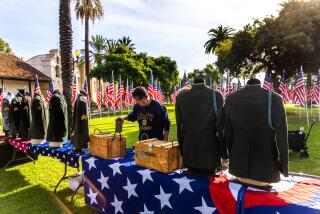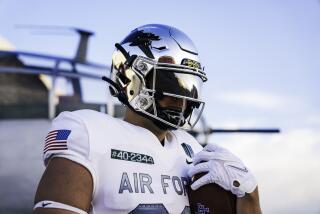‘Flyboys’ Reunite at Site of ‘40s Base
- Share via
COSTA MESA — “Let’s face it. Our steps are not as quick-paced and our backs are not as straight as they were during those Sunday afternoon dress parade marches,” 70-year-old Gerhard (Rusty) Rostvold told a crowd of several hundred former Army Air Corps cadets and personnel Saturday.
“But we are the lucky ones who are still around to gather here today,” said the popular former payroll sergeant, speaking at Orange Coast College to a reunion of cadets and base personnel stationed at the Santa Ana Army Air Base during World War II.
Rostvold was among more than 126,000 Army Air Corps cadets who were stationed at the hastily built base, which opened in 1942 on a 1,335-acre site now occupied in part by the OCC campus. The base closed in 1946.
Most cadets spent just a few months at the base, long enough to be tested, classified and given preflight training as pilots, bombardiers and navigators.
But a few, like Rostvold, were assigned to the base staff.
On his way to the campus auditorium Saturday, Rostvold, who lives in Laguna Beach, walked with his old friend Col. Frank Kirby, leader of the base’s original military band, who paused several times to trumpet the assembly call.
“Hearing that still gives me goose bumps,” Rostvold said.
The sound startled students, who were already staring curiously at the men talking animatedly in groups, some wearing natty bomber jackets.
These were the original top guns. Only back then they were called “flyboys” and, instead of F-14s, they piloted P-61s and P-38s. And the stories they tell about evading capture after crashing behind enemy lines are the stuff of movie plots.
Once inside the assembly hall, the jovial atmosphere subsided as the flag was brought in and the group respectfully recited the Pledge of Allegiance. A chaplain offered a prayer of remembrance for the nation’s war dead, underscoring the seriousness of the bygone era.
But romanticism prevailed during the luncheon when Col. Kirby struck up the band, leading off with the Army Air Corps Fight Song (“Off we go into the wild blue yonder. . . . “) and worked his way through the classic 1940s big-band repertoire.
“I was among the first group of cadets to arrive here,” said Bruce Percifield of Grass Valley. “When I heard broadcasts on the radio that the Japanese had bombed Pearl Harbor, I thought it was just another H.G. Wells ‘War of the Worlds’ spoof,” he said. “But within a few months I was here getting preflight training as a pilot.” Percifield flew 78 missions over Europe in a P-47 Thunderbolt.
At the opposite end of the table from Percifield, Charles Reddig was proudly flashing a card identifying him as a member of the Caterpillar Club. “You’ve heard the expression, ‘Hit the silks’? Well parachutes were made out of silk and anybody forced to bail out of an airplane was given one (a card) by the Irvin Airchute Co.”
Reddig, a P-51 Mustang pilot who bailed out behind enemy lines in France, was smuggled to safety by the French underground.
Listening intently nearby was Alvin Pinkley, the former mayor of Costa Mesa who operated Pink’s Drug Store just outside the base boundaries on Newport Boulevard, near what is now Broadway. Pinkley remembers how the base affected the community, which was just a tiny farm town back then.
“It was a big boom for us,” he recalled. “The army hired hundreds of local people to work on base. And there were a nice bunch of boys stationed there too.”
But the best stories were told by Rostvold. He shared a barracks with baseball great Joe DiMaggio, who was inducted into the army in the prime of his baseball career.
“He used to give us rides into Santa Ana in his gray Cadillac convertible,” Rostvold said. “I came here from a small mining town in Minnesota, and the base was the foundation for everything good that happened in my life from then on, especially the friendships I made.”
More to Read
Sign up for Essential California
The most important California stories and recommendations in your inbox every morning.
You may occasionally receive promotional content from the Los Angeles Times.













